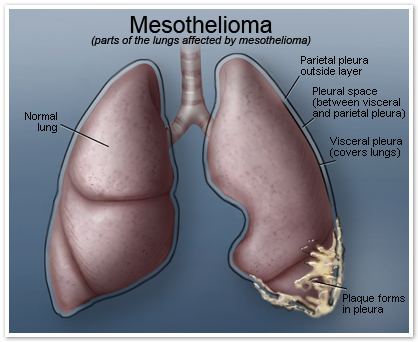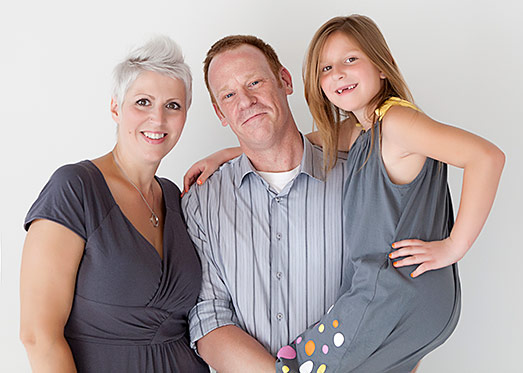Heather Von St. James was just 36 years old when she was diagnosed with malignant mesothelioma. The aggressive form of cancer, which affects the membrane lining of the lungs, abdomen and, rarely, heart, is most often diagnosed in people between the ages of 50 and 70. Von St. James was the mother of a 3-month-old when she discovered she had the most serious of asbestos-related diseases.
“I’m a new mom and I’m having all these weird symptoms,” Von St. James recalled in an interview. She attributed her fatigue to being a mother of an infant and a low-grade fever to hormonal fluctuations. “I was short of breath, but I figured it may have something to do with having had a c-section or because I was breastfeeding.”
Von St. James lost a significant amount of weight and grew increasingly anemic, pale and “bone-weary,” she said. Yet it wasn’t until she passed out for a couple hours on the couch when she was home alone with baby Lily that she finally called the doctor. An x-ray revealed that she had excess fluid around her lungs, what’s called a pleural effusion.
She was referred to a pulmonologist for a CT scan and a thoracentesis, a procedure that draws the fluid out of the lung. “There was over a liter of fluid around my left lung,” said Von St. James. “It was crunched up to about half its size.”
The CT scan revealed a mass in the lower left portion of her lung. She was scheduled for a needle biopsy the next day. Two weeks later, the biopsy results came back: She had malignant pleural mesothelioma. A surgical biopsy performed by the Mayo Clinic confirmed the disease two days prior to Christmas.
[youtube https://www.youtube.com/watch?v=f_1-3e7ZdAs]
The leading cause and risk factor for mestholioma is asbestos exposure. Asbestos is a naturally occurring mineral that was once ubiquitous in daily life, thanks to its strength and insulation properties, while being both lightweight and fireproof. It was woven into fabric, like fireproof vests, as well as mixed with cement or used as insulation in residential and commercial construction.
 Between 2,500 and 3,000 new cases of mesothelioma are diagnosed in the U.S. each year. Not surprisingly, construction workers—especially plumbers, pipefitters, steamfitters and electricians—are most vulnerable to asbestos-related diseases, according to Mesothelioma Cancer Alliance. As asbestos was widely used in ships, tanks, aircraft and trucks and was used all over military bases from the 1930s to the mid-‘70s, approximately a third of all Americans with mesothelioma are military veterans.
Between 2,500 and 3,000 new cases of mesothelioma are diagnosed in the U.S. each year. Not surprisingly, construction workers—especially plumbers, pipefitters, steamfitters and electricians—are most vulnerable to asbestos-related diseases, according to Mesothelioma Cancer Alliance. As asbestos was widely used in ships, tanks, aircraft and trucks and was used all over military bases from the 1930s to the mid-‘70s, approximately a third of all Americans with mesothelioma are military veterans.
“It affects them disproportionately more so than any other cancer,” said Von St. James. “Many navy ships hulls had been lined with it, so navy veterans are especially at risk. It was used in brake pads, so army and marines who worked on jeeps have gotten it. Asbestos is anywhere where there’s insulation in things.”
Von St. James said that those most at risk for mesothelioma today are DIYers who are demolitoning old houses. They are unknowingly exposing themselves to asbestos-containing vermiculite in building insulation. Now a known carcinogen, the use of asbestos has been largely restricted, and it has been banned in more than 50 countries—although not in the U.S.
So how did the young, former hair salon owner get the disease? Von St. James acquired mesothelioma from secondary exposure to asbestos—her father worked construction while she was growing up, and she frequently wore his clothing.
“In his early years, he did a lot of sanding, cleaning up after drywall installation and mudding. A lot of drywall mud, drywall and insulation had asbestos in it. Those fibers would go airborne and settle into his coat,” she explained.
During the cold Minnesota winters, her father’s coat was always hanging in the entryway, so she would put it on for any quick trips outside. “I wore this coat when had to go outside and feed my rabbits because I didn’t want to get my coat dirty,” she said, also recalling that his car was always dusty.
Her father eventually developed renal carcinoma, or kidney cancer. He passed away from the disease this past February. Von St. James believes asbestos is what caused her father’s carcinoma as well.
 Mesothelioma can affect the lung, stomach and rarely the heart. Peritoneal mesothelima affects the stomach, causing bowel issues, like constipation, vomiting, pain and swelling in the belly, as well as swollen feet. Von St. James developed pleural mesothelima, which affects the lungs. Common symptoms include:
Mesothelioma can affect the lung, stomach and rarely the heart. Peritoneal mesothelima affects the stomach, causing bowel issues, like constipation, vomiting, pain and swelling in the belly, as well as swollen feet. Von St. James developed pleural mesothelima, which affects the lungs. Common symptoms include:
• Shortness of breath
• Anemia
• Chest pain that doesn’t go away
• Dry cough
• Difficulty swallowing
• Persistent, low-grade fever
• Weight loss
The disease is further differentiated by type of cell, with the more easily distinguishable epithelial cell as the most common. These types of cancer cells are most commonly associated with pure lung cancer. Sarcomatoid, grown out of supportive structures, like muscles and bones, is less common and has a grimmer prognosis. Biphasic mesotheliomas have a mix of the two cell types, with a prognosis of 15 to 18 months.
“Most pleural mesothelioma patients die within 15 months of first developing symptoms,” Von St. James said. According to Mesothelioma.com, only 8 percent are expected to live three to five years from the disease onset. It wasn’t a prognosis someone with a three-month-old wanted to hear.
Her doctor advised that her best option was to go to Boston to see Dr. David Sugarbaker, who had developed a groundbreaking new surgery where the lung would be removed. “Without the surgery, and with chemotherapy and radiation alone, my survival would be 5 years at the most,” she said, “but with the surgery, I could live up to 10 years or more.”
Her husband said, “Get us to Boston.”
 In February 2006 at Brigham and Women’s Hospital, Von St. James had what is known as an EPP (for Extrapleural Pneumonectomy). The affected lung, the lining of the chest (or pleura), the lining of the heart (or pericardium), the left half of her diaphragm and a rib were removed. After surgery, she had a heated chemotherapy wash, where the medicine is pumped into the chest and “swished around” in a procedure known as the shake and bake.
In February 2006 at Brigham and Women’s Hospital, Von St. James had what is known as an EPP (for Extrapleural Pneumonectomy). The affected lung, the lining of the chest (or pleura), the lining of the heart (or pericardium), the left half of her diaphragm and a rib were removed. After surgery, she had a heated chemotherapy wash, where the medicine is pumped into the chest and “swished around” in a procedure known as the shake and bake.
“It was in clinical trial when I had it nine years ago,” said Von St. James. “[Dr Sugarbaker’s] perfected the technique.”
She had four sessions of chemo and 30 session of radiation for a total of one year of treatment from diagnosis to last radiation treatment. Today, nine years later, she considers herself very much a “normal person.” She keeps active around the house and takes walks. “You only need two lungs to float,” she quips.
She does experience shortness of breath walking up several flights of stairs or in really cold weather. She is also sensitive to cigarette smoke, strong perfumes and laundry detergent aisles. She switched over to the Clean+Green cleaner products, which are non-toxic and fragrance free.
As she had to give up working in the toxic environment of a hair salon after surgery, her husband went back to school after her diagnosis, while working full-time. “He did it for two years, graduated at the top of his class and never missed a day of school,” she said. Asked to give a speech at graduation, her husband said, “If my wife can beat cancer, I can do this.”
His sacrifice inspired the Mesothelioma Cancer Alliance Scholarship, which kicks off this year. As leading mesothelioma advocates, the Von St. James created the scholarship for anyone who has battled cancer or who has a loved one with cancer. “Cancer can be such a financially devastating thing,” Von St. James said.
The $4000 per semester scholarship will be awarded to a full-time student at an accredited university or college. Students must have a GPA of 3.0 or higher to be eligible. The deadline is Dec. 1 for the Spring 2015 semester and March 31 for Fall 2015. Applicants must submit a typed essay or video submission describing how cancer has affected them, how it has changed their outlook on life, and what the scholarship would mean for them.
“I hope some of the scholarship winners are inspired enough to go into research or medical field, like nursing or medical school,” she said. “Education is the future.”
For more details, visit www.mesothelioma.com/scholarship


Leave a Reply